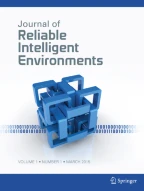Avoid common mistakes on your manuscript.
Our journal starts its second year of production, and provides a forum for a new community which is interested in creating more reliable Intelligent Environments. This is a concern which, to some extent, all those working in the area are sooner or later faced with. Still, the new components of this family of systems make less obvious the safer strategies to follow when designing, building and deploying Intelligent Environments. Our community has to adapt previously existing methodologies and tools and create new ones; we have to also seek inspiration in new related areas and keep our minds flexible to find inspiration which may arrive from other communities. The three scientific contributions we present in this issue reflect this initial search we have embarked on and represent interesting examples of different pieces (or dimensions) of the complex puzzle we are called to build. The first article exploits evolutionary algorithms to face a practical problem one has to face when setting up a real (intelligent) environment. The second paper deals with the need of designing quality attributes such as resiliency, which are becoming intrinsic, non-functional, characteristics required for whatever intelligent environment. The third article, instead, explores new dimensions for reliable systems represented by mathematical and theoretical properties such as antifragility.
In detail, A Genetic Algorithm Approach to Motion Sensor Placement in Smart Environments, by Brian Louis Thomas, Aaron S. Crandall, and Diane J. Cook; relates both to the ‘design’ as well as to the ‘deployment’ phases of creating an Intelligent Environment. These systems are highly dependent on sensors, and typically the environments where the infrastructure is deployed present variations which in some cases can be so substantive that they degrade the service deliver quality. Hence the importance of being able to assess how many sensors of each type have to be deployed and how to place them relative to each other so that the system is fed with the expected data to work properly. There is also a financial dimension in this exercise as finding out the minimal number of sensors required for the system to deliver services whilst maintaining quality of services encourages technology uptake. The authors present a very interesting analysis of several techniques to inform the optimal arrangement of a set of sensors which we believe will be of high interest to our readers in academia and industry.
Formalization of Resilience for Constraint-Based Dynamic Systems, by Nicolas Schwind, Morgan Magnin, Katsumi Inoue, Tenda Okimoto, Taisuke Sato, Kazuhiro Minami, and Hiroshi Maruyama; approaches an Intelligent Environment containing a number of networked devices as an instance of a general and flexible computational framework which represents the systems specifications through a Constraint Optimization Problem (COP). System components are represented by variables, the possible states of these components correspond to the domain of these variables, and interactions between the components are represented through constraints. The authors generalize previous state trajectories strategies into a dynamic systems perspective by considering the notion of a “strategy” operated by the system controller through time. A central consideration in this paper which is relevant to Intelligent Environments is the possible occurrence of exogenous events. A system is resilient if there exists a strategy for it that provides a guarantee that all state trajectories possibly adopted by the system are resilient.
Taxonomy and Issues for Antifragile-Based Multimedia Cloud Computing, by Syed Fawad Haider, Laraib Abbas, Amjad Ali, Muddesar Iqbal, Imran Raza, Syed Asad Hussain, and Xinheng Wang; provide a survey on the management of Multimedia Cloud Computing (MCC) which has implications for cloud services as a backbone for intelligent environments. The authors provide a comprehensive
m state of the art account of resource management and taskanagement in MCCs followed by a critical analysis and open research issues in MCC which can be a helpful guide for researchers and developers in the area of Intelligent Environments to reassess how to address these issues in their future innovative products.
We believe these communications are of the interest of colleagues in academia and industry and will lead to the improvement of systems being currently build.
Author information
Authors and Affiliations
Corresponding author
Rights and permissions
About this article
Cite this article
Augusto, J.C., Coronato, A. Editorial. J Reliable Intell Environ 2, 1–2 (2016). https://doi.org/10.1007/s40860-016-0018-6
Published:
Issue Date:
DOI: https://doi.org/10.1007/s40860-016-0018-6
